Project work with the Non-Business and Non-Profit Sector – Student Innovative Project for Social Benefit 2016-2020 for the academic year 2019/2020.
Researching the history of hosiery and designing modern and upcycled hosiery – SOCKS
Mentors: Živa Zupin, Petja Zorec, Ana Motnikar
Students: Gašper Gajšek, Zala Hrastar, Zala Mavrić, Anita Miklavčič, Elizabeta Petrovčič, Klara Rešetič, Petra Schwarzbartel, Maruša Turk, Lara Vidmar, Iris Vrhovski
Faculty of Natural Sciences and Engineering, University of Ljubljana, Aškerčeva 12, 1000 Ljubljana
Faculty of Education, University of Ljubljana, Kardeljeva ploščad 16, 1000 Ljubljana
Slovene Ethnographic Museum, Metelkova ulica 2, 1000 Ljubljana
Project duration: March – July 2020
The main objective of the project is to research the evolution of hosiery from the beginnings to modern hosiery for different purposes, to prepare workshops for different target groups organized by the Slovenian Ethnographic Museum based on sustainability, handwork, knitting. The main goal was the preparation of the exhibition in Slovenian Ethnographic Museum, where upcycling, reuse and Slovenian textile tradition of hosiery were presented.
Hosiery has been researched from the beginnings of sock wearing, the development of machine knitting from the first Lee knitting machine to modern hosiery knitting machines, hosiery for different purposes (sports, medicine, smart socks). The development of hosiery industry in Slovenia with focus on the biggest producers, Tovarna nogavic Polzela in Tekstilna tovarna Prebold. Interesting facts about nylon socks were found, ways to repair hosiery were researched. We also researched how to deal with the growing amount of textile waste and what can be done with waste hosiery to extend its life. All of these findings, research and literature reviews were recorded in the project paper that was produced as part of the project.
Material for workshops as video tutorials were prepared for different age groups (pre-schoolers, school children, families and retirees). In the workshops we introduced traditional hand knitting and knitting of socks, making toys from waste, used and unusable socks, which is related to the concept of reuse and recycling of textiles. The workshops were not held as the school and museums were closed at the time of the project due to the Covid-19 epidemic.
The online survey was conducted to find out what kind of socks people like to wear, what their favourite colours are, what their shopping habits are, which is also interesting from an ethnological perspective. We were also interested in what they do with worn out socks. The survey found that most respondents wear short socks, both for work and for leisure. Socks are associated with the concepts of warmth, heating, comfort, protection from cold, clothing, usability, etc. Only less than half of the respondents wear nylon tights, and only on special occasions. They most often wear socks in beige or black colour, with most consumers choosing thicknesses of 10 DEN, 15 DEN and 20 DEN.
The survey also revealed the respondents’ opinion on the sustainable aspect of using and handling already used socks. Most consumers continue to wear damaged (torn, thinned or worn) socks at home for some time or sew them up at least once. While used socks that they can no longer be worn are used to clean or to make Easter eggs. Most of the respondents would choose to buy products made from socks using the upcycling method.
The project ended on 3 July 2020 with the opening of the ŠTUMFI exhibition at Slovenian Ethnographic Museum. The ŠTUMFI exhibition joins the central exhibition of the Bosi. Obuti. Sezuti., which speaks of the coexistence of feet and shoes.
Based on the exploration of socks in art, their actual and symbolic meaning and their diverse aesthetics through historical eras, products with added value or artistic value were also created. By using (re)interpretation techniques, discovering the possibility of reusing used socks and upcycling, socks can become useful in new ways.
The results of the project are useful for the knowledge of Slovenian cultural and technical heritage, the development of knitting machines for hosiery, the knowledge of industrial knitting in Slovenia and the popularization of hand techniques. The project also strengthens environmental and sustainability awareness and self-sufficiency, as it involves upcycling and reusing already used socks or using industrial waste products. It also popularizes textiles and textile design.
The Faculty of Natural Sciences and Engineering has increased its collaboration with Slovenian Ethnographic Museum. Topics have been explored that will help the museum in its further research. Among the most useful are researches on the development of Slovenian hosiery factories, brands and modern trends in hosiery production. Research on the technical development of knitting machines will help the museum in dating the objects kept in the museum. The museum also acquired a machine for repairing nylon hosiery.
The materials created for the workshops are universally applicable, both for the museum and for conducting workshops in kindergartens, primary schools and elsewhere for different age groups.
All materials created during the project are available on the website of Slovenian Ethnographic Museum.
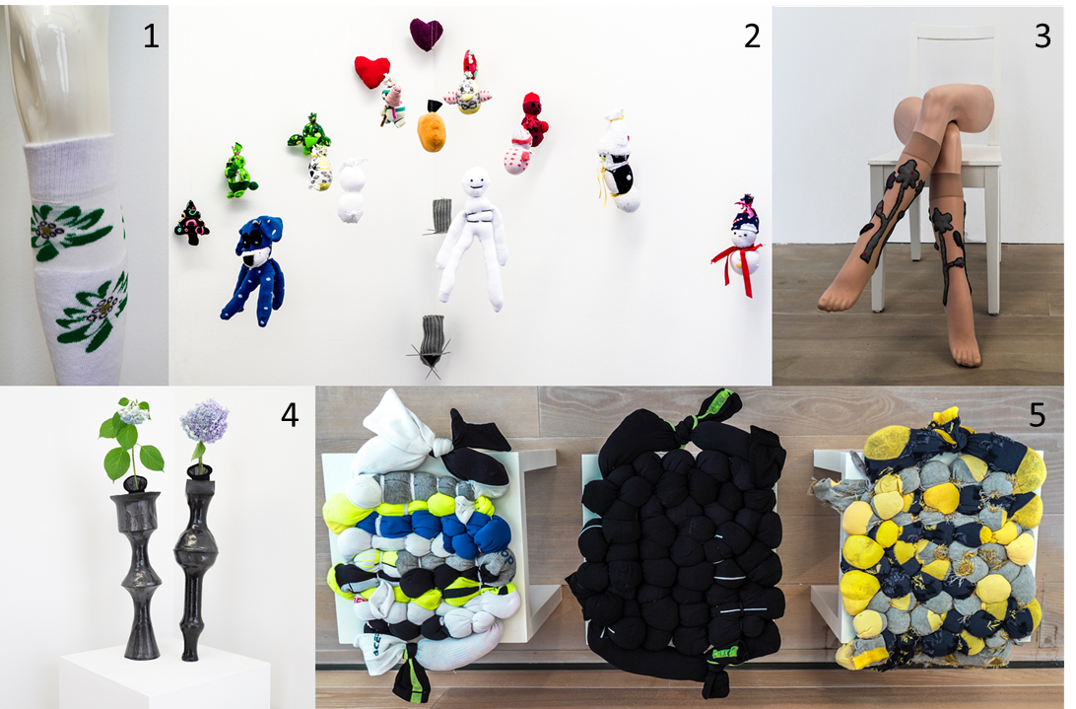
Figure 1: Planita sports socks by Anite Miklavčič (photo: Zala Mavrić).
Figure 2: Toys made from waste by Maruša Turk and Zala Mavrić and in the background a display of handmade socks by Petra Schwarzbartl.
Figure 3: The method of repairing the nylon stockings of Klara Rešetič Krčne cvetice (photo: Zala Mavrić).
Figure 4: Vases by Gašper Gajšek, made from nylon stockings (photo: Zala Mavrić).
Figure 5: Pillow family Živjo Živjo, made from sock waste by Zala Hrastar (Photo: Zala Mavrić).
Creative path to knowledge: Is the laundry really clean?
Mentors: Brigita Tomšiča, Petra Forte Tavčera, Rok Finkb, Nina Špičkac, Ivan Grčarc
Students: Anja Modica, Eva Jugb, Tanja Furlana, Iris Vrhovskia, Dominika Glažara, Laura Cimpermana, Ana Gerla, Teja Pirnata
a Faculty of Natural Sciences and Engineering, University of Ljubljana, Aškerčeva 12, 1000 Ljubljana
b Faculty of Health Sciences, University of Ljubljana, Zdravstvena pot 5, 1000 Ljubljana
c Belinka Perkemija, d.o.o., Zasavska cesta 95, 1231 Ljubljana – Črnuče
Project duration: March – July 2020
The main objective of the project is to optimize the process of household washing, ensuring effective removal of stains at low washing temperatures and producing hygienically safe textile surfaces and internal parts of the washing machine after each wash cycle.
EU directives prescribe the use of laundry care programs at lower temperatures (30-40 ° C) and lower water consumption. The latter, together with the growing trend of using liquid detergents in home textile care, raises serious doubts about the effectiveness of the washing process from an esthetic and hygienic point of view. Commercial products for the care of household textiles contain bleaching agents that allow the removal of stains and disinfection of the surface of textiles and internal parts of the washing machine even at low washing temperatures, but they are unstable in liquid detergents. Accordingly, several independent studies have shown the presence of pathogenic microorganisms on the surface of textiles after household washing at temperatures of 30-40 ° C, which is the possibility of spreading pathogenic microorganisms through textiles.
The work of the project team took place in three stages. The first stage involved a survey of textile care habits in Slovenian households, with 216 surveys conducted. The second and third stages involved determining the efficiency of the household washing process using different washing powders and liquid detergents with the addition of different concentrations of hydrogen peroxide to investigate the efficiency of removing colored stains and ensuring the cleanliness of the interior of the washing machine and the hygiene of the washed textiles. It was found that the average washing temperature in Slovenian households is 40 ° C, while 27% of respondents use only liquid detergents. It is also worrying that one fifth of respondents do not clean the gasket rubber of a household washing machine, which provides ideal conditions for the growth of enterobacteria, mold and yeast fungi, which were detected in half of the gasket rubber swabs taken from washing machines. Based on the results of laboratory washes, it was found that the addition of hydrogen peroxide of 0.5-1.0% by volume of the wash bath and a teaspoon of soda ash to achieve an alkaline pH effectively removed coloured stains from textiles at washing temperatures of 30-40 ° C. The presence of 0.5% hydrogen peroxide already provides a significant reduction in the amount of biofilm on the cotton surface by 82% relative to the number of cells before washing.
Such laundry hygiene prevents the transmission and spread of pathogenic microorganisms from person to person through contaminated laundry, as well as the possible cross-pollination of microorganisms from different environments and the emergence of new diseases.
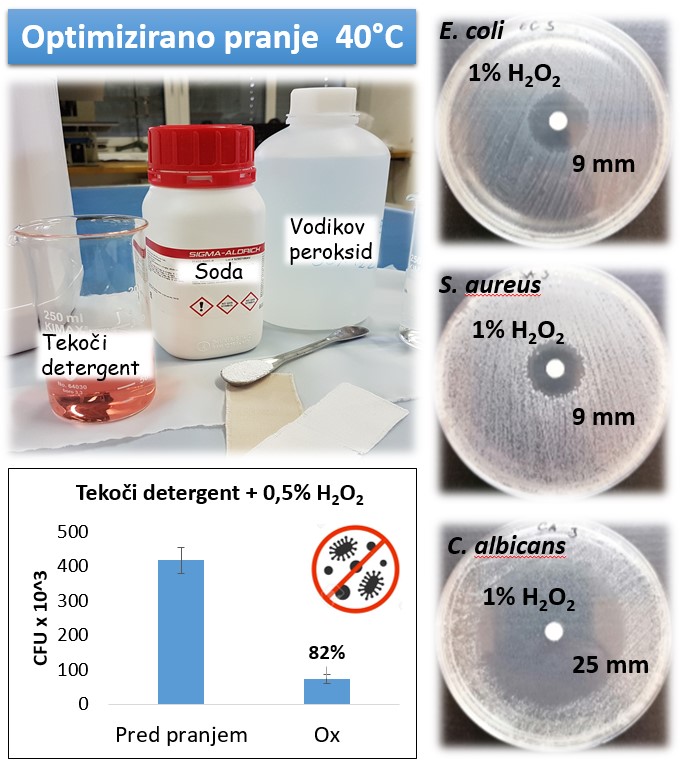
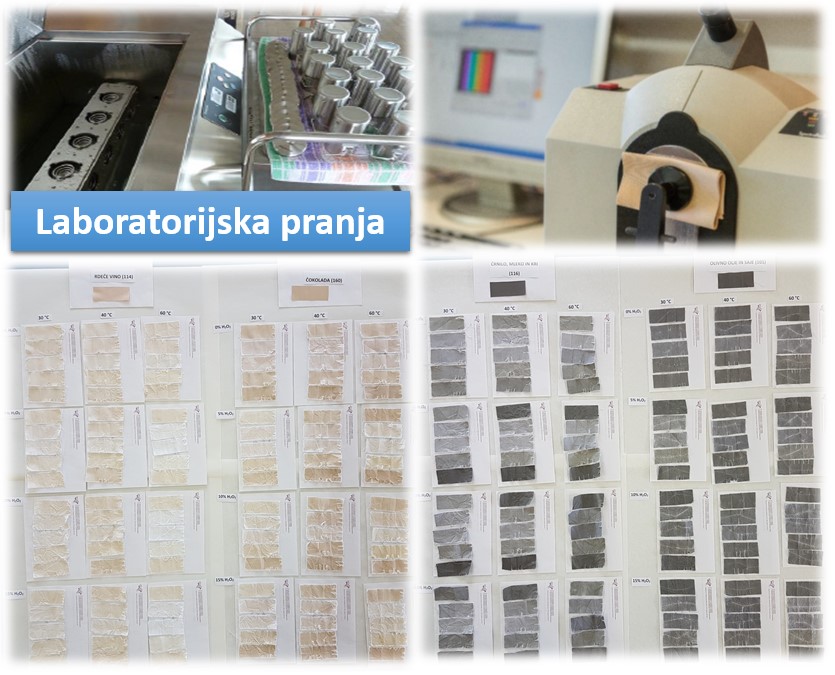
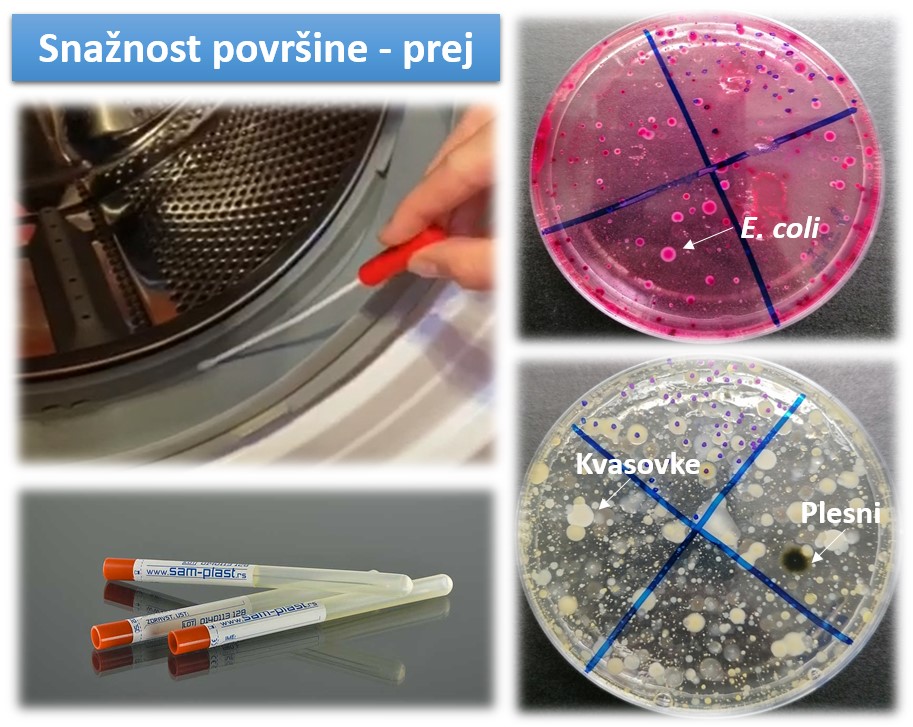
Creative path to knowledge: Alternative triangular bandage
Mentors: Damjan Slabea, Nevenka Ferfilaa, Eva Dolenca, Brigita Tomšičb, Matjaž Mohoričc
Students: Brigita Marca, Jakob Sketa, Lana Flisara, Katjuša Mežeka, Maja Štibernika, Tanja Furlanb, Tisa Kuretb in Karolina Gosencab
a Faculty of Health Sciences, University of Ljubljana, Zdravstvena pot 5, 1000 Ljubljana
b Faculty of Natural Sciences and Engineering, University of Ljubljana, Aškerčeva 12, 1000 Ljubljana
c Gornik Avantura, d.o.o., Kidričeva cesta 39b, 4220 Škofja Loka
Project duration: February – June 2019
Hiking, mountaineering, sport climbing are outdoor sports and recreational activities where the time available for rescue services is longer in case of an accident. Appropriate mutual first aid or self-help is therefore crucial. The first aider can assist in caring for the injured by improvising and / or using supplies from various first aid kits. The standard contents of the kits include a triangular bandage. Adequate quality of triangular bandages is particularly important in some first aid procedures, such as making an Esmarch bandage, immobilizing, making improvised stretchers, and securing the injured person on the stretcher. For adequate care of the injured person, only accessories made of high quality, health and ecologically appropriate materials are acceptable. Accordingly, the aim of the project was to produce a prototype of an alternative triangular bandage (ATB) made of materials that provide sufficient strength and elasticity and are suitable from a hygienic point of view. We aimed to add value to the ATB by printing up-to-date information on first aid measures, a more attractive appearance and better visibility.
The project team’s work took place in four stages. The first stage involved the study of the most common injuries in the mountains and the selection of first aid measures; the second stage involved the determination of the quality of existing triangular bandages on the market, the selection of a model textile fabric and the determination of the colour fastness of imprints in selected red and black colour on the model substrate; the third stage involved the preparation of the risk assignment of the materials used in the research; and the fourth stage involved the design of the newly developed ATB.
The result of the interdisciplinary collaboration of students from different disciplines is an ATB made of polyester, which is an alternative to cotton fabric and is more suitable for use in the mountains due to lower moisture absorption and higher strength. The new ATB allows various first aid measures to be carried out and, despite its classic triangular shape, can be used in several ways, for example as a headband, as a scarf around the neck or as a coat over the shoulders to protect against sunlight or cold. By choosing a fluorescent colour, the ATB also ensures better visibility. Printed first aid measures help in the quick selection of the appropriate first aid measure that is crucial for the rescue of the injured person and should ultimately also increase the promotion of the first aid.
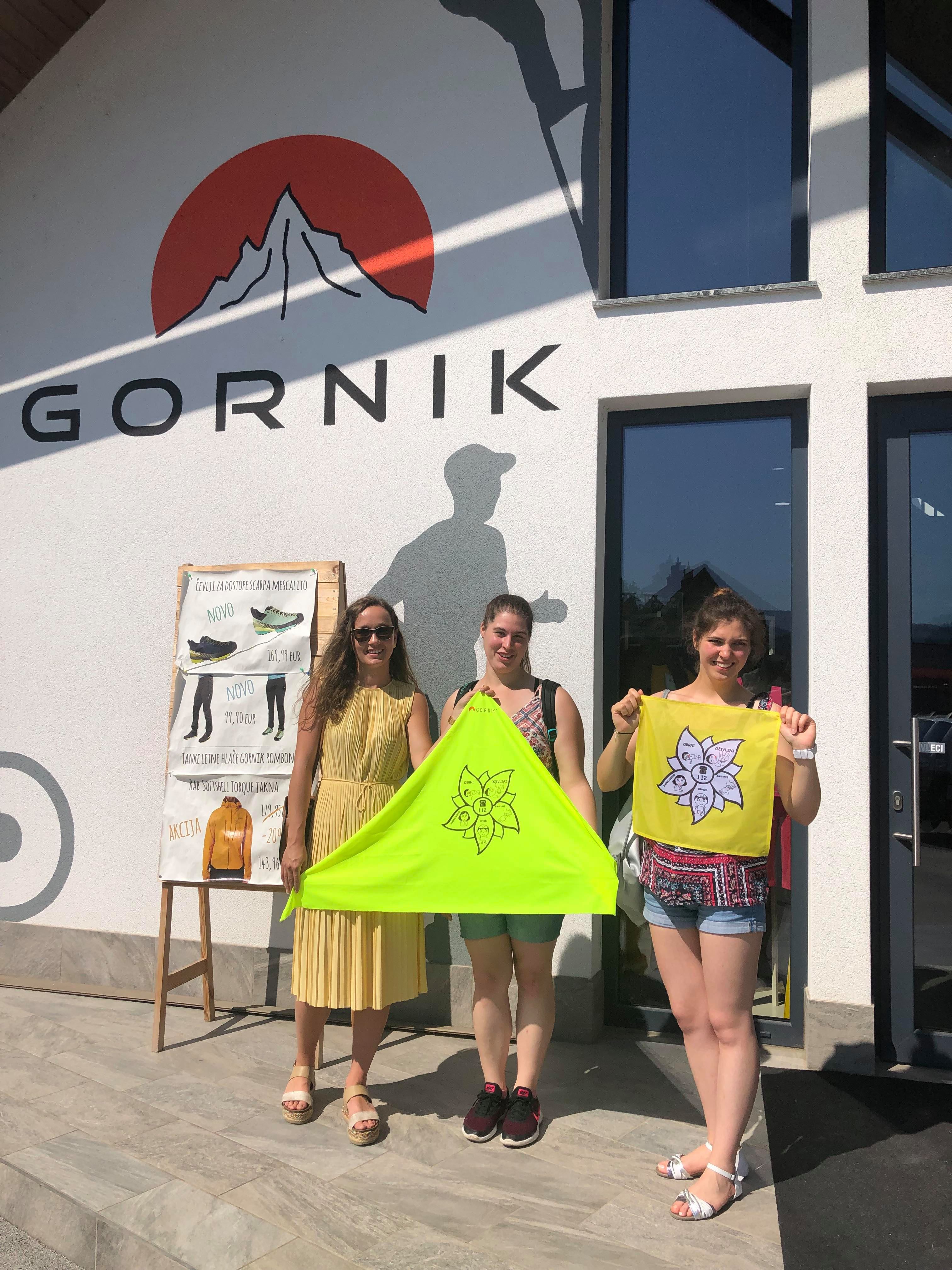
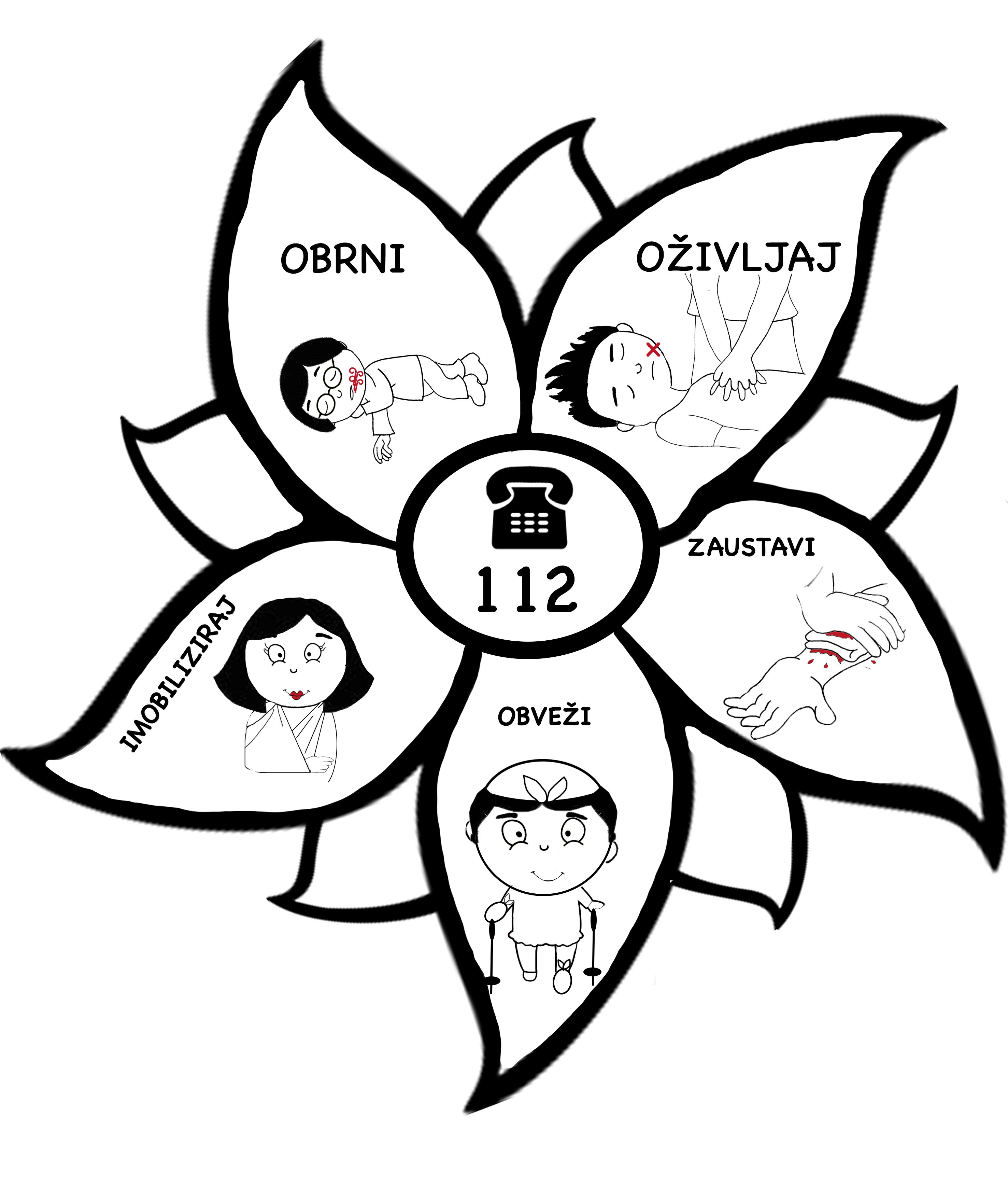
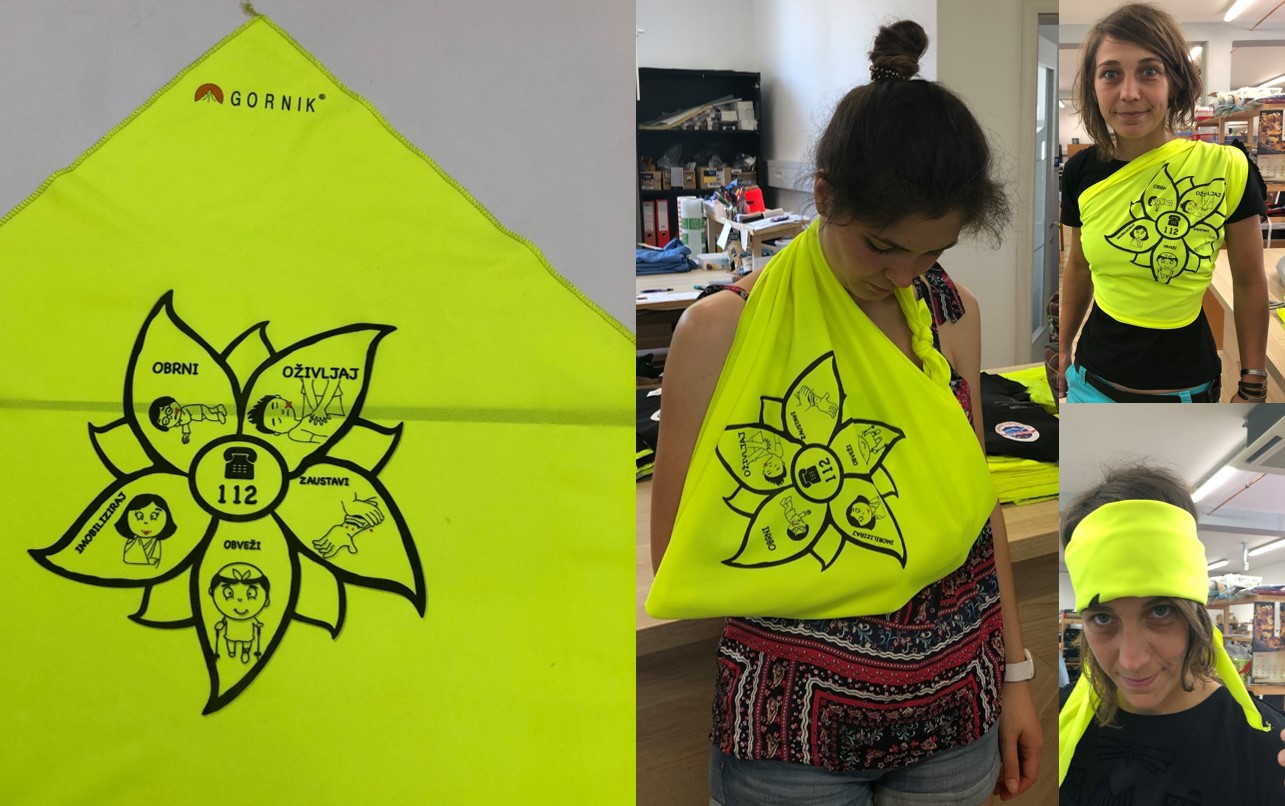
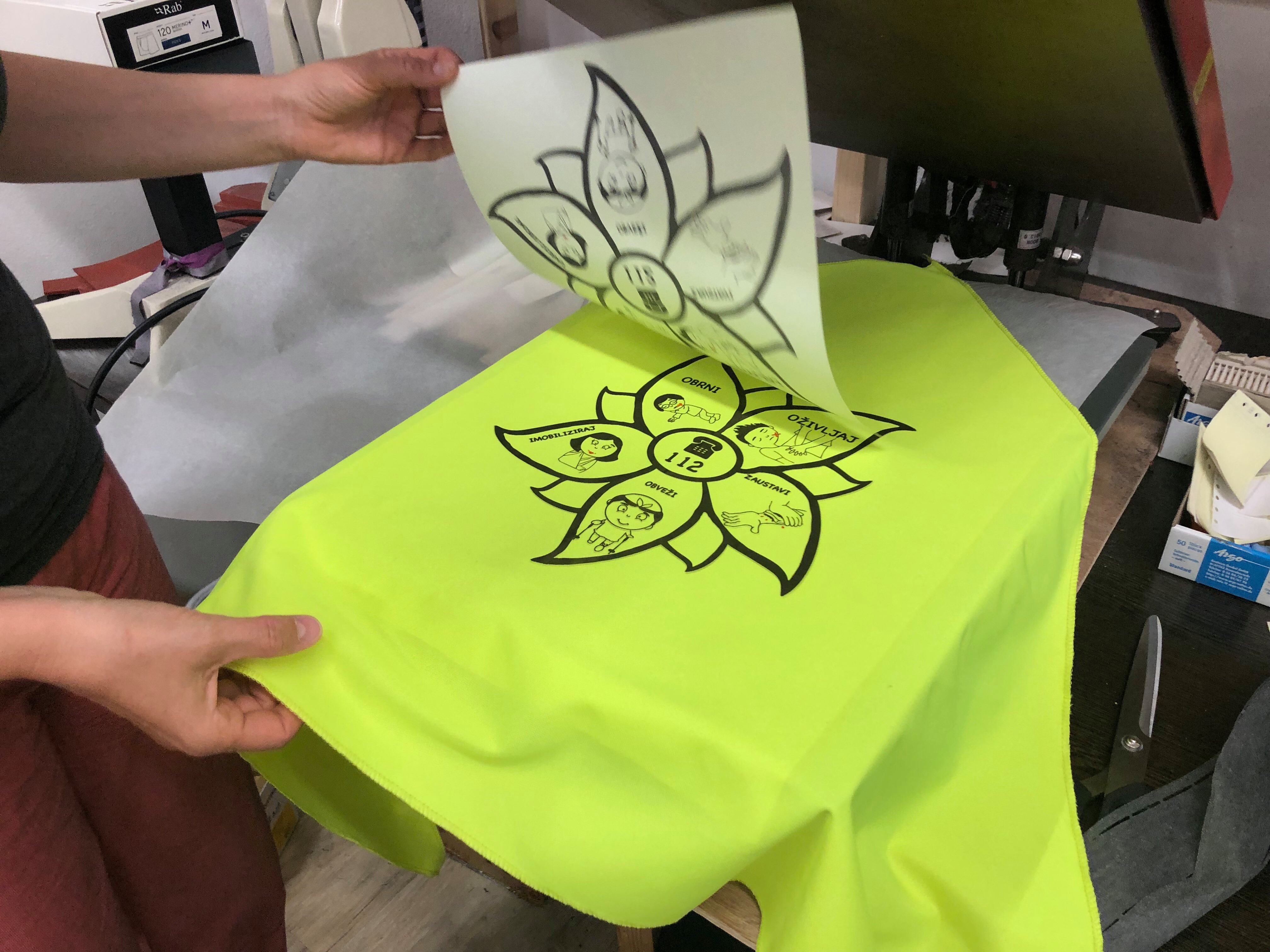
creUNI – Modern creations of national recognition elements and the possibilities of integration for formal uniforms
Leader: assist. prof. dr. Marija Gorjanc
Partners on the project: Faculty of Natural Sciences and Engineering (UL), Faculty of Economics and Business (UM), KOR TEKSTIL d.o.o., Zveza inženirjev in tehnikov tekstilcev Slovenije.
Number of students on the project: 6 from UL and 2 from UM
The purpose of the project was to create a design concept of a T-shirt with Slovenian motifs and to develop a protocol for the marketing of T-shirts for uniformed clothes. The primary target group of consumers are users of uniform clothing. In addition, we wanted to design a T-shirt for young people, so they can experience the beauty and richness of Slovenian cultural heritage in a more modern way. The project team included students of various skills and practices, such as design, textile technology and marketing. Students studied the background of motifs, their meaning and connection in Slovenian culture. The motifs that often occurred on historical textiles were digitized and redesigned by students to form a single motif that will be printed on the shirt. Students also studied the suitability of digital printing with reactive dyes on textiles made of bamboo viscose (100% or mixed with cotton or polyester) and colour fastness. The students also prepared conceptual solutions for design, tailoring and producing prototype T-shirts as a part of uniformed clothing and T-shirts for young people. In order to create a T-shirt marketing protocol, the students studied modern marketing methods, analysed the market situation and studied a market communication. In cooperation with the company KOR TEKSTIL, the students learned about the technological process of designing and manufacturing clothing (design, technical drawing, materials, tailoring, assembly). Students learnt about the needs and limitations on the market. In the working environment of KOR TEKSTIL, students also learnt the importance of networking and marketing, and how it is important to develop Slovenian textile products. Students participated in the marketing approach for the preparation of materials for the sale of original products with the Association of Textile Engineers and Technicians of Slovenia.
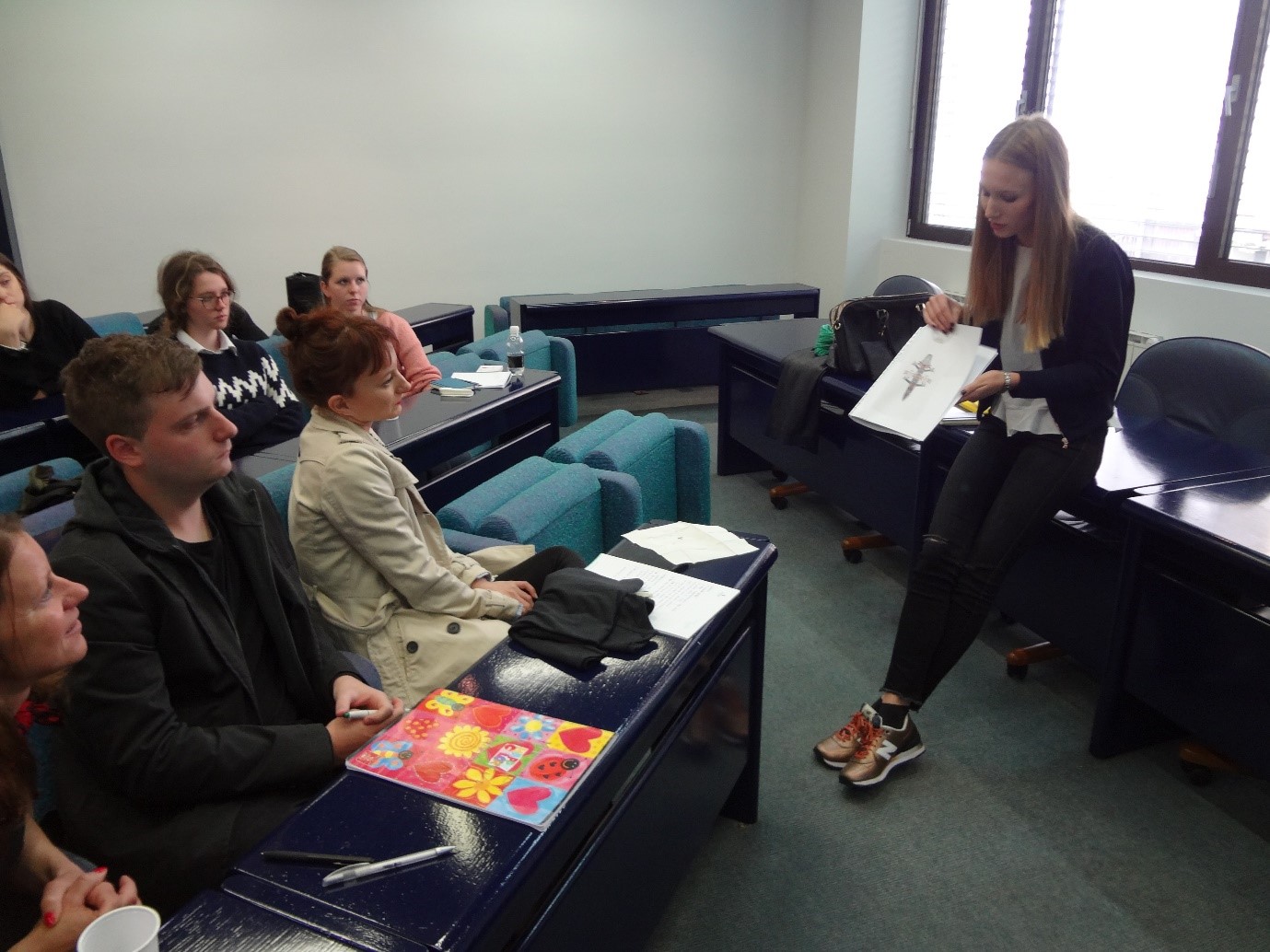


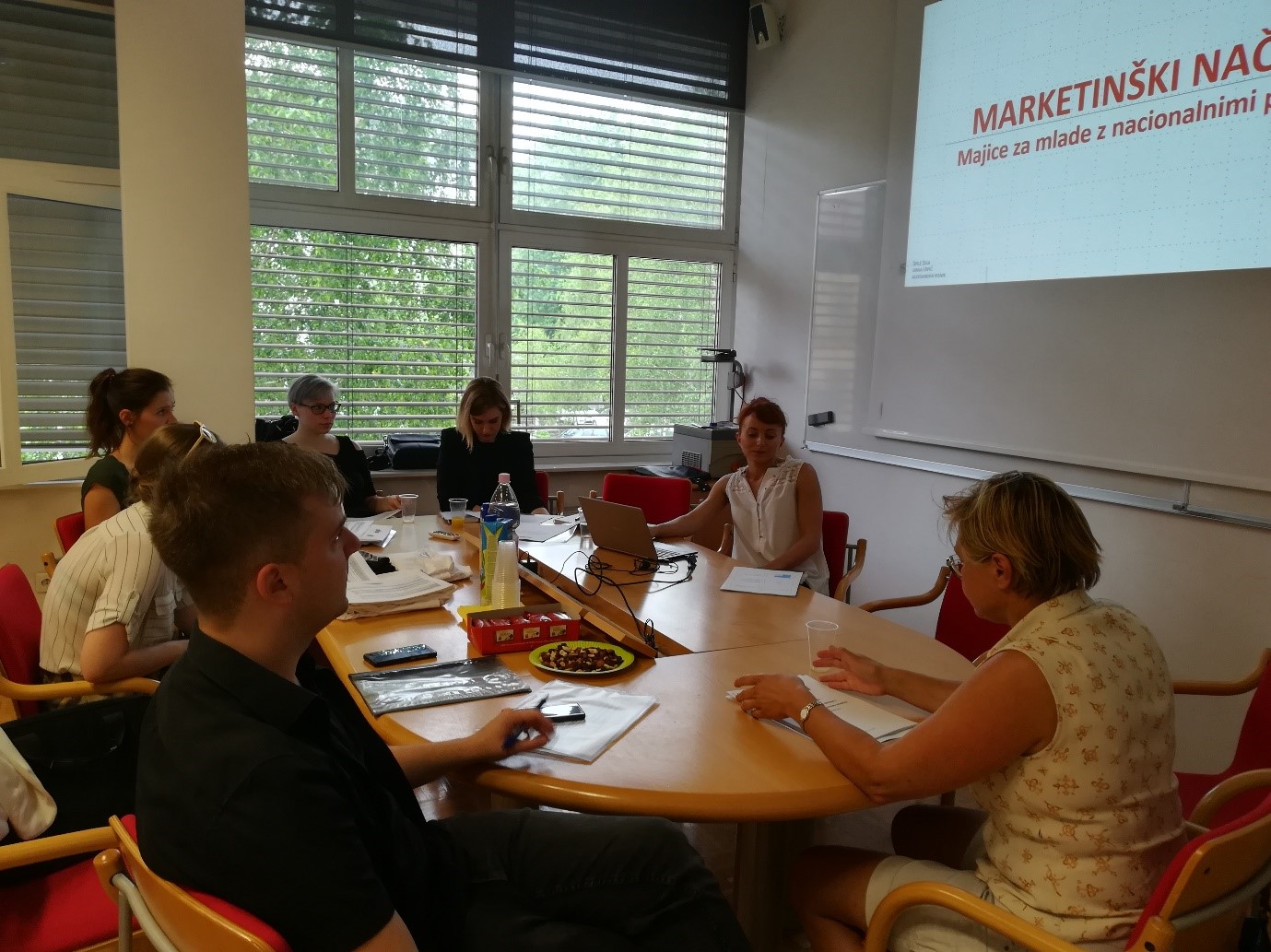
Textile students exhibition “Ljubljanski cek’r”, project within the 1st Bologna study programme course Computer assisted design for printing
Students: Škurta Avdijaj, Ana Jan, Anja Jermančič, Sandra Krebelj, Nina Logar, Petra Miloševič, Katarina Rajevec, Sabina Stipič, Sara Stipič, Neža Sukič, Nika Župan, Laura Fajfar
Mentors: Marija Gorjanc, Alenka More
The exhibition presents the work of textile students (2nd and 3rd year Textile and Clothing Planning and 3rd year Textile and Clothing Production) that have designed and produced an environmentally friendly bag with the motif of Ljubljana. The inspiration for the motif came from walking the city or from their memory of a favourite location. Using a professional computer program for drawing vector graphics, the students drew a motif of Ljubljana and produced a print form. The form was printed onto cotton fabric; the fabrics were tailored into bags. The students demonstrated the ability to carry out ideas in practice, thereby stressing the importance of knowledge of textile technology. This project was also presented as a contribution to the 45th Symposium on Novelties in Textiles in the form of oral presentation.
Creating superhydrophobic and oleophobic cotton fabric dyed with reactive dyes – original scientific research work of students in 2nd Bologna study programme
Students: Tina Mandelj, Rahela Kurent, Kristina Zdovc, Katarina Drevenšek, Nina Pajsar
Mentors: Mateja Kert, Barbara Simončič, Brigita Tomšič, Marija Gorjanc
Within the scope of the course Advanced finishing processes of the postgraduate study programme Textile and Clothing Planning, students researched the influence of dyeing with three reactive dyes – Avitera SE, i.e. yellow, red and blue – on the functional properties of cotton fabrics finished with SiO2 nanoparticles, hydro- and oleophobic finish (FAS) and the combination of both (SiO2+ FAS). At the same time, the influence of applied finishes on the colour change of dyed cotton fabrics was also studied. Superhydrophobic properties were obtained in the case of all studied samples and were not affected by previous dyeing. Despite the application of SiO2 nanoparticles, the samples did not obtain self-cleaning properties. Application of finishes led to oil repellency, which slightly increased on the previously dyed samples. The finishes showed good washing resistance. The colour of undyed and dyed samples was strongly influenced by the presence of finishes. The dyed and finished samples had poor light fastness, which was visible from the colour differences results. The results of the research were presented at the 45th symposium on Novelties in Textiles and as an original research article in the journal Tekstilec.
Visual and functional properties of digital printed and finished anaglyph pictures on cotton fabric – original scientific research work of students in 2nd Bologna study programme
Students: Špela Zakrajšek, Danaja Štular, Špela Vasič Stepančič
Mentors: Petra Forte-Tavčer, Barbara Simončič, Marija Gorjanc, Brigita Tomšič
Within the scope of the course Advanced finishing processes of the postgraduate study programme Textile and Clothing Planning, students researched the influence of various protective finishes on the visual properties of anaglyph images and CMYK primary colours digitally printed on a cotton fabric. Using the impregnation process, one-component water- and oil-repellent finishes, flame retardant finishes and a combination of both were subsequently applied on the printed samples. A visual evaluation was determined for the 3D visual effect of printed samples. The results showed that the presence of finishes changed the colour properties of prints; however, it did not impair the 3D effect of the anaglyph image, which was maintained even after repeated washings and exposure to artificial light. The prints did not influence the functional repellent and flame retardant properties. However, the impaired wash fastness of finishes was observed. The results of the research were presented at the 44th Symposium on Novelties in Textiles and as an original research article in the journal Tekstilec.
Creation of “lotus effect” on cotton fabric with use of plasma, enzymes and sol-gel finishing – original scientific research work of students in 2nd Bologna study programme
Students: Katja Jazbec, Anja Maloprav, Mateja Godec
Mentors: Barbara Simončič, Petra Forte-Tavčer, Marija Gorjanc
Within the scope of the course Advanced finishing processes of the postgraduate study programme Textile and Clothing Planning, students researched the influence of the pretreatment of cotton using environmentally friendly processes, i.e. plasma and enzymes, on the quality of hydro- and oleophobic sol-gel coating. The results showed that the pretreatment of cotton using plasma and enzymes results in the creation of micro- to nanostructured surface roughness of fibres, increased water contact angle higher than 150°, decreased sliding water angle and increased oleophobicity of sol-gel finished fabric. The “lotus effect” was most noticeable on the finished samples pretreated with plasma. The chemical modification of fibres did not change the stiffness of the fabric; however, it did slightly worsen its breaking force. The results of the research were presented at the 43rd Symposium on Novelties in Textiles and as an original research article in the journal Tekstilec.